Videos
 Friday, June 19, 2009 at 08:05PM
Friday, June 19, 2009 at 08:05PM I've uploaded several more videos.
Breaking the bottom out of a bottle
 impulse momentum in
impulse momentum in  video
video  Friday, June 19, 2009 at 08:05PM
Friday, June 19, 2009 at 08:05PM I've uploaded several more videos.
Breaking the bottom out of a bottle
 impulse momentum in
impulse momentum in  video
video  Monday, June 8, 2009 at 04:39PM
Monday, June 8, 2009 at 04:39PM I'm starting to upload the videos that Betsy Baum (thanks!) took of me at the Maker Faire. First up, walking barefoot on broken glass.
Walking Barefoot on Broken Glass. from Marc "Zeke" Kossover on Vimeo.
 Pressure,
Pressure,  broken glass in
broken glass in  News,
News,  video
video  Friday, June 5, 2009 at 07:46PM
Friday, June 5, 2009 at 07:46PM I won an Editor's Choice Award for my physics presentation at the Maker Faire! Woo hoo!
 Sunday, May 31, 2009 at 10:19AM
Sunday, May 31, 2009 at 10:19AM The easist solution is to buy the full thing from Pasco, but at $319 it is expensive. A kit that includes everything but the board and air supply is cheaper at $139 but is still costly but not outrageous, especially if you already own a cordless leaf blower. I really recommend this kit.
Building your own is pretty cool too. This set of plans from Bill Beatty (my hero) explains what to do really well and will set you back less than $50 plus the cordless leaf blower.
However, you can combine both of these sets to get a great design for a bit less money. Make the skirt in Bill's plans by using ballistic nylon like Pasco uses. Buy a yard and a half of 330 or 500 denier cordura nylon, like this stuff. Cut it into a circle a couple of inches larger than your hovercraft disk. Hem a hollow edge all the way around the outside of the circle. Follow Bill's advice for cutting circles out of the center. Thread a piece of stiff wire around the seam. By pulling the wire tight, you can keep the skirt attached to the board.
You will need to seal the skirt along the edge. Staples and silicone sealant will probably work, but heavy staples and heavy tape work well too. A rubber bumper like the one Pasco sells used to be available online, but the company where I saw it has gone out of business. (Thanks Steve for telling me!) I'm looking for a replacement.
 newton's laws in
newton's laws in  Demos
Demos  Friday, May 29, 2009 at 09:22AM
Friday, May 29, 2009 at 09:22AM 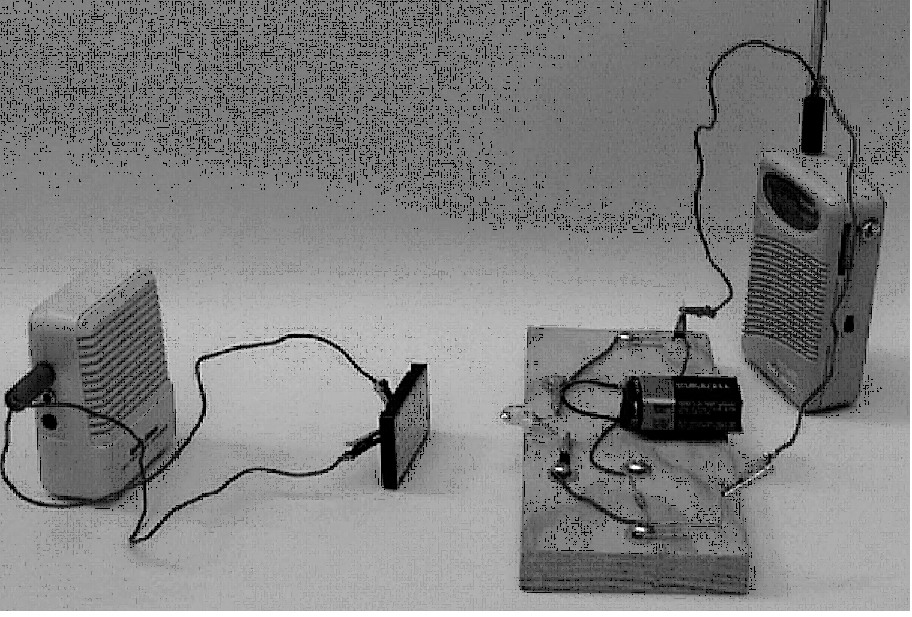
Connect an LED to the output of an audio source in such a way that the LED flashes with the source. Then attach an applified speaker to a solar cell and presto you are communicating via light.
<http://www.exploratorium.edu/square_wheels/modulated_led.pdf>
The Exploratorium has a series of books called "Snacks" which explain how to make cool science experiments. Unlike some other books, though, the experiments actually work, and also unlike other some other books their books come with correct explanations of the science behind them. Check out a selection at
http://www.exploratorium.edu/snacks/
You can find the books at most big public libraries. See a list at Amazon here.
Oh, full disclosure, I work/volunteer with the Exploratorium, but I've never worked on a Snack book.
 electricity,
electricity,  sound in
sound in  Demos
Demos  Friday, May 29, 2009 at 12:01AM
Friday, May 29, 2009 at 12:01AM Tap water conducts electricity, which seems kind of weird since water isn't a metal and has a covalent bond. Of course it conducts because it has ions dissolved in it that can move around and act like the electrons (in a way) as those in a wire. Pure water without ions is a lousy conductor.
Glass is the prototypical example of an insulator. It too is composed mostly of non-metals and has a covalent bond. And like tap water it too has ions. Why doesn't it conduct?
The ions are frozen in place, of course. Let's not argue whether or not room temperature glass is a solid -- suffice it to say that the particles aren't going anywhere fast. On the other hand, if you melt the glass, then the ions can move and then it will conduct electricity.
How to do this? Connect two lamp bases in series and then connect them to a wall plug protected by a GFCI. Carefully break the glass globe off a bulb. You will see a plug of glass with two wires coming out of it. The wires are in turn connected to the filament. Clip the wires to the plug of glass. Put an intact bulb in one socket and a the broken bulb in the other socket. Plug them into the wall. Careful, careful. You've got live current here. The GFCI will help but it's not perfect.
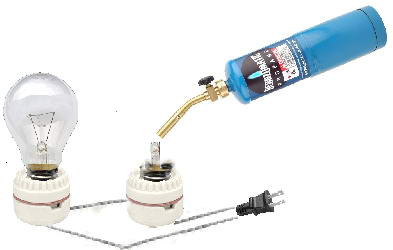
Take a torch and heat the glass plug until it glows red/orange. The other bulb will then light up. Notice that the plug will stay molten from the heat running through the wire. Unplug the apparatus. The bulb will go out and the molten glass will cool. If you plug it back in before the glass freezes, the bulb will light up again. If you unplug and wait until the glass is cooler (although still hot enough to burn you) before plugging it back in, then the bulb will not go back on.
 electricity in
electricity in  Demos
Demos  Thursday, May 28, 2009 at 11:46AM
Thursday, May 28, 2009 at 11:46AM 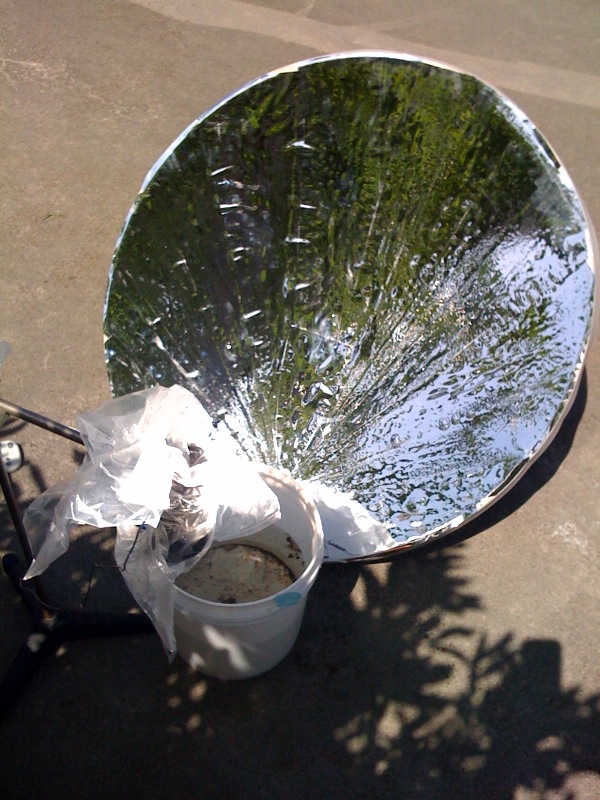
According to solarcooking.org:
Solar cooking is the simplest, safest, most convenient way to cook food without consuming fuels or heating up the kitchen. Many people choose to solar cook for these reasons. But for hundreds of millions of people around the world who cook over fires fueled by wood or dung, and who walk for miles to collect wood or spend much of their meager incomes on fuel, solar cooking is more than a choice — it is a blessing. For millions of people who lack access to safe drinking water and become sick or die each year from preventable waterborne illnesses, solar water pasteurization is a life-saving skill. The World Health Organization reports that in 23 countries 10% of deaths are due to just two environmental risk factors: unsafe water, including poor sanitation and hygiene; and indoor air pollution due to solid fuel use for cooking.
Plans <http://solarcooking.org/plans/> I like the solar funnel which is really easy to build.
My design is different than any of these and relies on the availabilty of satellite television dishes. In San Francisco, I often see Direct TV and Primestar parabolic dishes being thrown away -- not the receiver mind you -- just the metal dish. I then rubber cement aluminized mylar to the dish. These are amazing. They can get a pint of water to 160 degrees F in about 20 minutes and boil a like amount of water in about 30 minutes.
 Kossover, Zeke
Kossover, Zeke

Fun last March. Could get up to about 320 degrees, but not all the way to popping corn. Grrr.
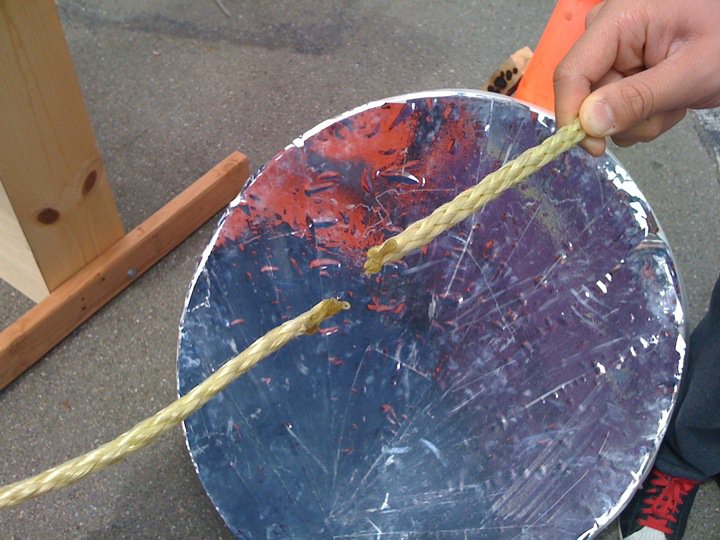
I was at the Exploratorium in April 2011, burnng wood with my giant Fresnel. I also brought this parabolic mirror which I forgot about. After a while the rope broke, having been melted by the hot spot from the mirror. Oops.
 environmental science,
environmental science,  optics in
optics in  Demos
Demos  Wednesday, May 27, 2009 at 04:32PM
Wednesday, May 27, 2009 at 04:32PM The electric pickle doesn't really show anything useful, but it's fun. The pickle always glows on only one side, but not always the same one. The glow is clearly from sodium ionization like a sodium lamp. Presumeably the current heats up the pickle and boils water away and at some point ionizes the sodium. It will go for some time but once you unplug the pickle it won't glow again.
This gives a starting explanation, and I always like a link to Hyperphysics <http://hyperphysics.phy-astr.gsu.edu/Hbase/electric/pickle.html>
Some plans here.
 electricity in
electricity in  Demos
Demos  Wednesday, May 27, 2009 at 01:27PM
Wednesday, May 27, 2009 at 01:27PM 
The plans to the right are from Brown University. Click to go there.
Jumping Ring video from MIT. Embedding disabled. More videos from Wake Forest.
.pdf plans from Sam Sampere are simplier to build.
 Wednesday, May 27, 2009 at 01:17PM
Wednesday, May 27, 2009 at 01:17PM Not me in the video, by the way.
Eddy currents. The magnet falls far slower than you'd expect because it generates electricity in the pipe as it falls. That electricity then generates a magnetic field in opposition to the magnet's field slowing the fall. Coolmagnetman has a good site expaining what is happening and a couple of cool experiments to try with it.
Bill Beaty's (my hero!) has lots of cool stuff about rare earth magnets here including excellent plans and sources for pipe.
 Magnets,
Magnets,  eddy currents in
eddy currents in  Demos
Demos  Tuesday, May 19, 2009 at 04:09PM
Tuesday, May 19, 2009 at 04:09PM 
Lots of sites explain how to put them together. I like Sam Sampere's construction plan, but I use BYU's method of sealing the ends with Mylar.
This article from California State Chico does a great job of explaining the physics of the cannon.
More on figuring out the speed.
 vacuum cannon in
vacuum cannon in  Demos
Demos  Tuesday, May 19, 2009 at 04:05PM
Tuesday, May 19, 2009 at 04:05PM  The singing rod works via stick-slip forced vibration leading to resonance similar to a wine glass. However, the natural frequency of the rod is higher than the wine glass, so you need rosin to make your fingers more sticky rather than more slipprey like in a wine glass. This is rather more detailed than you will probably want.
The singing rod works via stick-slip forced vibration leading to resonance similar to a wine glass. However, the natural frequency of the rod is higher than the wine glass, so you need rosin to make your fingers more sticky rather than more slipprey like in a wine glass. This is rather more detailed than you will probably want.
One note, the first site at the Whelmers suggests that the singing rod is vibrating transversely. I'm pretty sure that's not the case. Put the end in water and you will see the water making concentric circles which looks quite a bit different than what a tuning fork looks like in water.
http://www.mcrel.org/whelmers/whelm10.asp
http://www.arborsci.com/detail.aspx?ID=491
 resonance,
resonance,  sound,
sound,  stick slip in
stick slip in  Demos
Demos  Tuesday, May 19, 2009 at 03:55PM
Tuesday, May 19, 2009 at 03:55PM 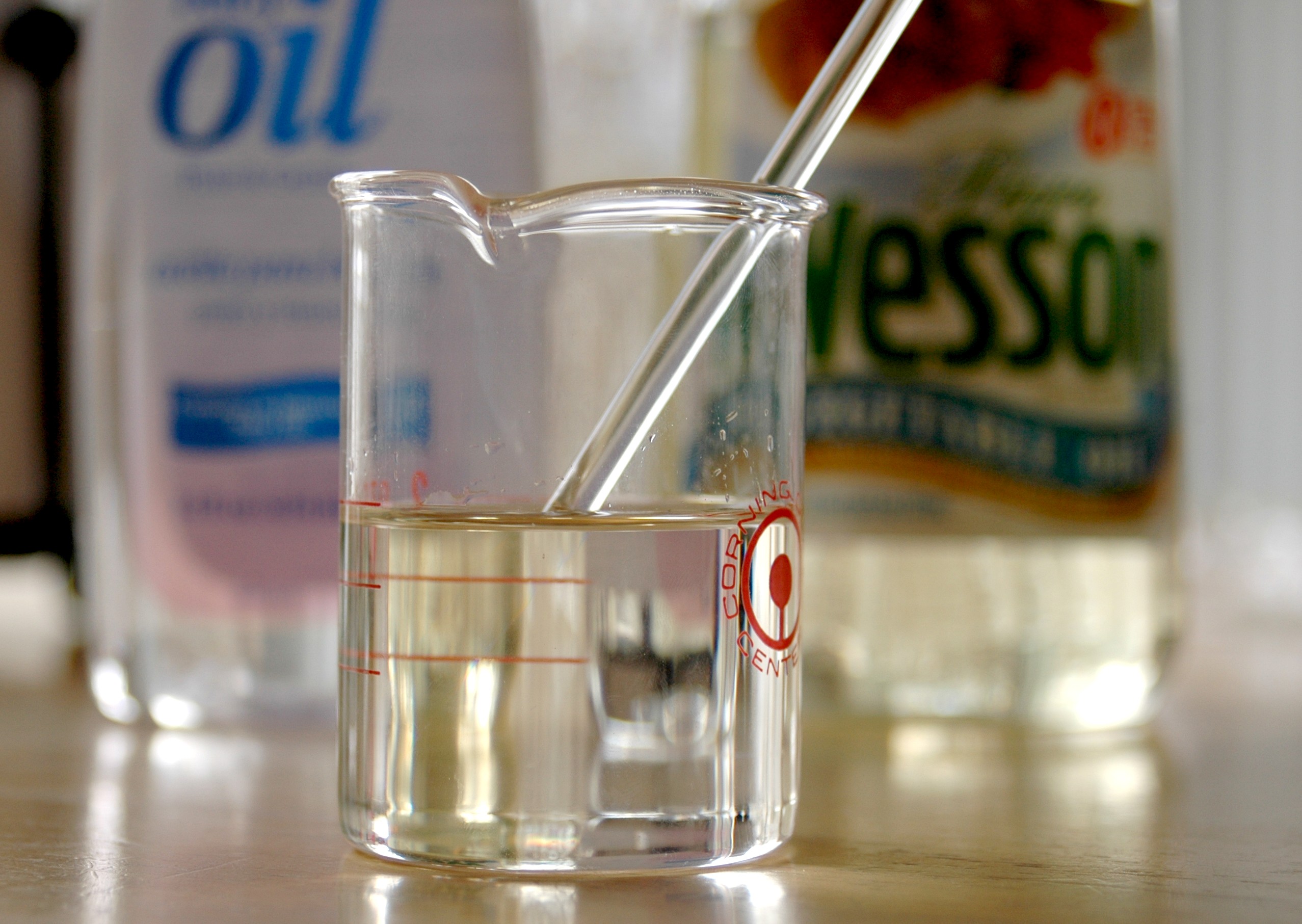
Philosophical sounding question: How can you see somthing that is clear like water or glass? Reflections, yes, but more so, distortions of light coming through. The distortion is caused by light being bent when it changes index of refraction. This site will teach you how to mix up a solution with the same index of refraction as Pyrex. When submerged, the glass will be invisible.
http://gr5.org/index_of_refraction/babywess.jpg
http://www.exploratorium.edu/snacks/disappearing_glass_rods/index.html
 Index of refraction in
Index of refraction in  Demos
Demos  Tuesday, May 19, 2009 at 03:00PM
Tuesday, May 19, 2009 at 03:00PM 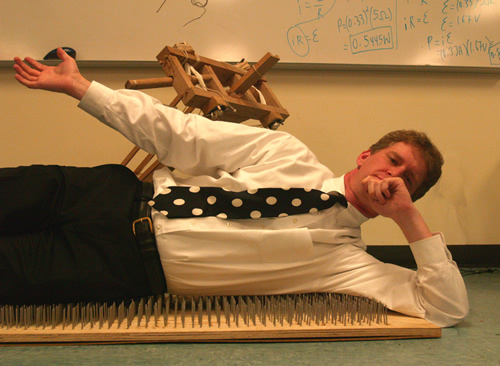 Lots of good sources here. Start with this Australian site http://www.keypoint.com.au/~skeptics/Bed_of_Nails which does a good job of explaining how to make a bed, although I'd recommend going with galvanized or stainless steel nails even though they are harder to insert. Rust is a bad thing here.
Lots of good sources here. Start with this Australian site http://www.keypoint.com.au/~skeptics/Bed_of_Nails which does a good job of explaining how to make a bed, although I'd recommend going with galvanized or stainless steel nails even though they are harder to insert. Rust is a bad thing here.
This U. Pitt site gives a pretty good take as well. http://www.pitt.edu/~dwilley/Show/NailBed2.html.
If you have access to The Physics Teacher, there's a great article published in October 2004.
Another method with a video.
 Tuesday, May 19, 2009 at 02:58PM
Tuesday, May 19, 2009 at 02:58PM The bed is 70 pounds of broken glass, mostly window panes. Yes, I walk on it barefoot. No, I haven't cut my feet yet. No, I don't have students do it.
I followed David Wiley's advice pretty much exactly. http://www.csicop.org/si/9911/willey.html
Who knew that everytime I was doing this activity I was deriving some valuable reflexology benefits? http://www.lifeevents.org/walking-barefoot-on-broken-glass.htm
 Tuesday, February 24, 2009 at 03:31PM
Tuesday, February 24, 2009 at 03:31PM Down to a Science is a science cafe in San Francisco where the host Kishore plays a more active role than in most science cafes. In February 2009 he had a presentation on new directions in science education, and I was there to talk about high school science. He posted a video on YouTube. My part begins at about the 30 minute mark.
Click on the video to get a larger image.
 Down to a Science,
Down to a Science,  optics in
optics in  News
News  Friday, November 7, 2008 at 04:47PM
Friday, November 7, 2008 at 04:47PM  Magazine,
Magazine,  Science Cafe in
Science Cafe in  News
News  Thursday, February 28, 2008 at 04:40PM
Thursday, February 28, 2008 at 04:40PM  Ask A Scientist in
Ask A Scientist in  News
News